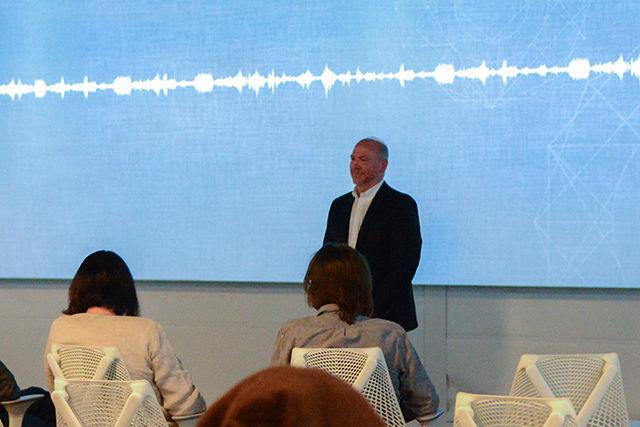The Hunt Library Teaching and Visualization Lab presented the second showing of Sound of September: a 9/11 Sonic Narrative on Thursday. Narrated by Mark Evans, a graduate student studying art and design, this immersive presentation was displayed across five screens and featured source audio from the attacks on the World Trade Center.
Evans was in the World Trade Center when the first plane struck, and Sound of September narrates his story hour by hour, from the moment he woke up to the moment he escaped the carnage. One of the few visuals in the presentation was a timeline of events, giving the audience a sense of perspective.
“It started out as 100 percent personal,” Evans said. “I’ve been wanting to tell this story in a more formal way through media for a long time.”
As a master’s candidate, one of the factors that led to his audio-based presentation were the time and technical constraints of creating a visual piece. This wasn’t the most significant explanation behind this presentation’s unique layout, though. More than a sense of urgency, Evans’ memory and autobiographical experience inspired the use of source audio and narration.
“The process was taking off the personal experience hat and putting on the creative director hat and saying, ‘how can I condense this personal timeline that was about really four hours depicted in this 13-minute piece,’” Evans said.
The audio in the piece was drawn from archival news footage, personal voicemails and recordings from the street. The only audio that was not a source recording was the music and sound effects. Starting with the sound of an alarm, to brushing teeth, to birds singing, the audio conveyed a sense a normalcy.
“There’s something about hearing what he heard, the heartbeat, the voicemails, it all really got to my emotions,” said Lauren Wilder, a graduate student studying art and design and a classmate to Evans.
According to Evans, the audio allows audience members to imagine their own visuals, making the experience more personal. Sound lets the audience fill in the blanks in the narrative, making it a more involved, almost interactive experience. For Evans, sound was crucial to his memories of the attack.
“I inevitably talk about how I experienced the day,” Evans said. “Sure, it was visual, but for me, I had a sensorial response that was a heightened sense of sound. That was another driving catalyst in my design process to do this through sound, because why would I fight the obvious? That’s how I experienced it, I should tell it that way.”
Aside from the presentation’s content, the use of technology and setting added to its impact. The setup of the screens and the audio created a distinct environment for the audience.
“The most impactful thing I took away from it was actually the audience’s interaction with the film,” said Ian Clement, a graduate student studying art and design. “The people, no matter what happened, kept their bodies facing forward because we’ve been trained to do that for movie theatres. So, it’s kind of interesting to see how humans have evolved with the media.”
Hunt Library has already requested another showing of Sound of September. Evans would also like to expand his project to multiple venues, such as the Museum for Contemporary Art and Design in Raleigh and the National September 11 Memorial and Museum.
“It’s important for me to share this story, because it’s in tribute to the lives that were lost and the lives that were affected in some way,” Evans said. “It’s also in tribute to the people that survived.”








